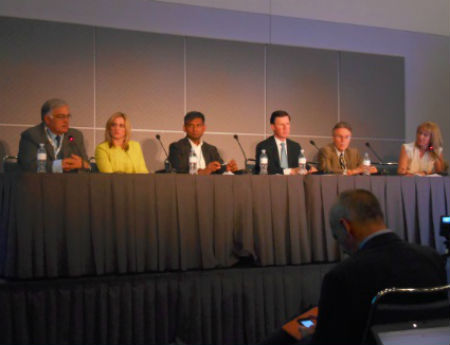Cable Show: MSOs Prepared To Enter Gigabit Era

Los Angeles – In a wide-ranging discussion at The Cable Show on Tuesday, a handful of the cable’s top tech and engineering execs said technologies such as DOCSIS 3.1 position them well to offer Gigabit-level broadband services as they increasingly find themselves matched up with competitors such as Google Fiber and AT&T and the potential expansion of the telco’s fiber-based “U-verse with GigaPower” platform.
Time Warner Cable, which is pairing off with Google Fiber in Kansas City, is wary of that competition, but has found that the new entrant has had limited success and that some customers are coming back because they like TWC’s video service better.
Google Fiber “is certainly a worthy competitor, if they’re going to overbuild us,” but that they offer “nothing dramatically different” than what TWC can bring to bear, Mike LaJoie, TWC’s executive vice president and chief technology and network operations officer, said. “Their product works. Our product works just as well.”
Cable’s incremental economics are generally better than someone who is entering the market in a greenfield situation and looking to cherry pick, Tony Werner, Comcast’s EVP and CTO, said, noting that Comcast has raised its speeds 13 times in the last 12 years and has begun to make 100 Mbps (downstream) its main flagship product in the Northeast and will look to continue that trend.
Competition has sharpened the focus on launching faster services, but “it hasn’t changed our priorities,” Kevin Hart, the EVP and CTO of Cox Communications, said, noting that the MSO is on a path to offering 150 Mbps to 200 Mbps services across its footprint.
Looking ahead, cable will be looking to compete with even faster speeds enabled by DOCSIS 3.1, a next-gen platform that will put cable on a path toward 10 Gbps down and at least 1 Gbps upstream. The cable industry announced that it will use "Gigasphere" as the consumer-facing name for the services that will be enabled by DOCSIS 3.1.
“You’ll see us being aggressive buying 3.1 product,” said Werner, who expects one chipmaker to have initial silicon ready and built into D3.1 modems by the second quarter of 2015, with two other suppliers to follow suit by the third or fourth quarter of next year. On the cable modem termination system side, vendors are telling him they’ll be ready for downstream trials in 2015, and full-fledged products ready by 2016, paving the way for initial deployments.
Multichannel Newsletter
The smarter way to stay on top of the multichannel video marketplace. Sign up below.
The “hardware seems to be on a very good path,” Werner said.
As part of its preparation for DOCSIS 3.1, Cox, Hart said, has initiated an all-digital initiative that will allow it to reclaim analog spectrum for use toward other services. He expects Cox to complete its all-digital project by 2016.
Semi-Bullish On 4K
Panelists were generally bullish about 4K/Ultra HD, believing that the eye-popping format represents the next HD, which was a hit, more than the next 3D, which was a complete dud.
“There’s less friction” with 4K, which doesn’t require consumers to don special glasses, Balan Nair, Liberty Global's chief technology officer, said, hopeful that Liberty Global will have devices in hand before the 2016 Olympic games in Rio de Janeiro, Brazil.
Werner said he expects 4K adoption to occur at a slower pace than HD, but that it is poised to be a bigger success than 3D-TV.
4K has promise, but any rollout will have to be tied to High Efficiency Video Coding (HEVC), Yvette Kanouff, EVP, corporate engineering & Technology at Cablevision Systems, said, referring to an emerging codec that is 50% more efficient than H.264/MPEG-4.
Weighing In On Aereo
Panelists were also asked to weigh in on the Supreme Court case involving Aereo, the startup that relies on an array of thumb-sized antennas and a cloud-based infrastructure to deliver live TV and DVR services.
Cablevision has expressed an opinion to the Supreme Court that while it agrees with broadcasters that Aereo's service is an illegal violation of copyright, it likewise believes the broadcasters’ position could jeopardize cloud-based storage, which Cablevision relies on for its network DVR service.
“I think after last week [when the Supreme Court heard the case] we feel pretty strongly about our position on what cloud services can offer and where we are,” Kanouff said.
Werner, who was present at the hearing, said the lawyers on both sides made good arguments, and that the justices will have a “tough job” as they weigh their final decisions.
“What’s clear to me is they were concerned about how it relates to cloud computing and cloud storage,” he said, adding that it will be interesting to see how they can “thread the needle.”
Noting that Liberty “nearly invested” in Aereo, a bad outcome for the startup might simply delay the sort of service that cable might not yet be ready to compete with. “It delays the inevitable,” he said. “But the cable industry could probably use that breathing room.”
